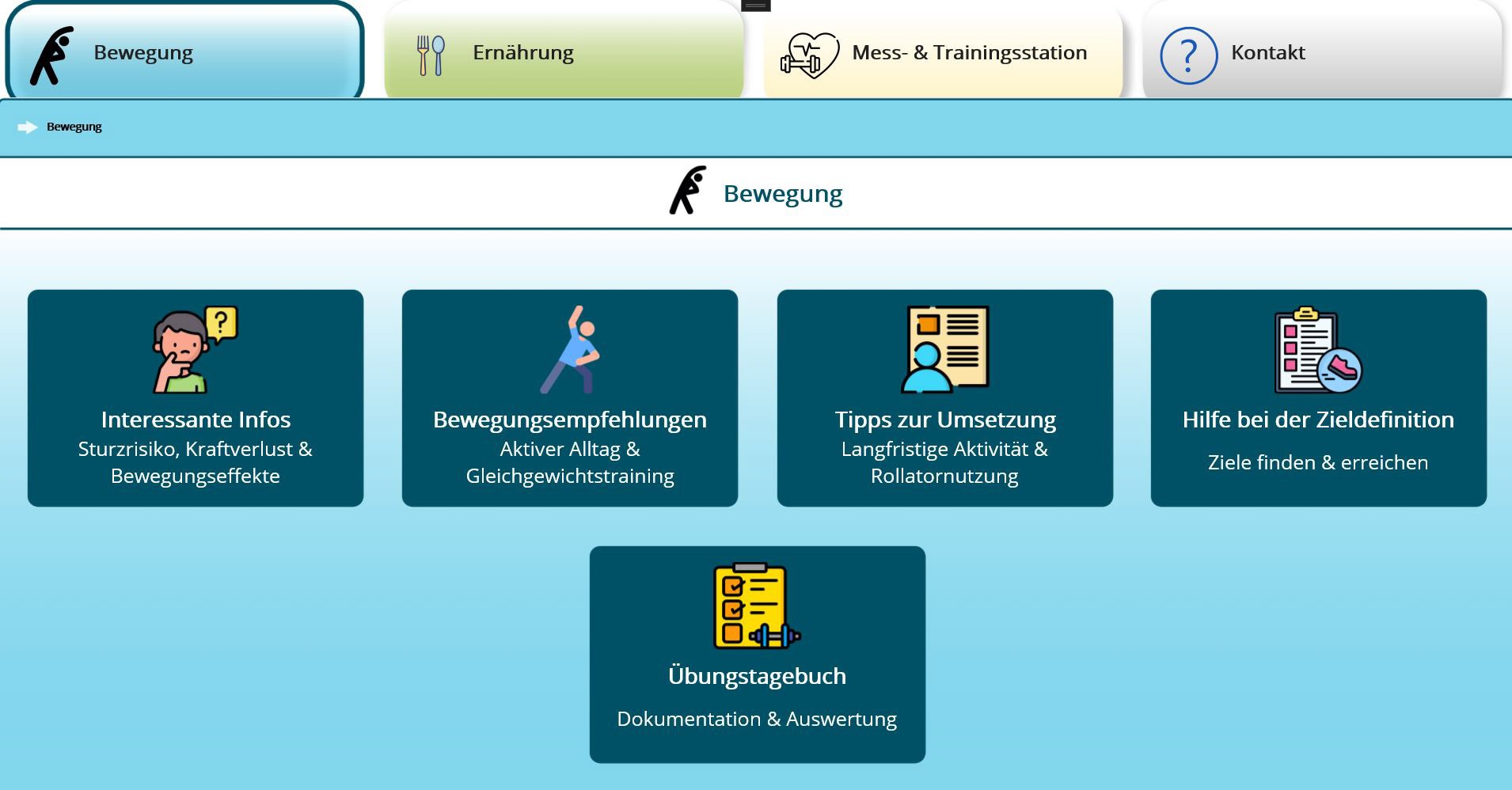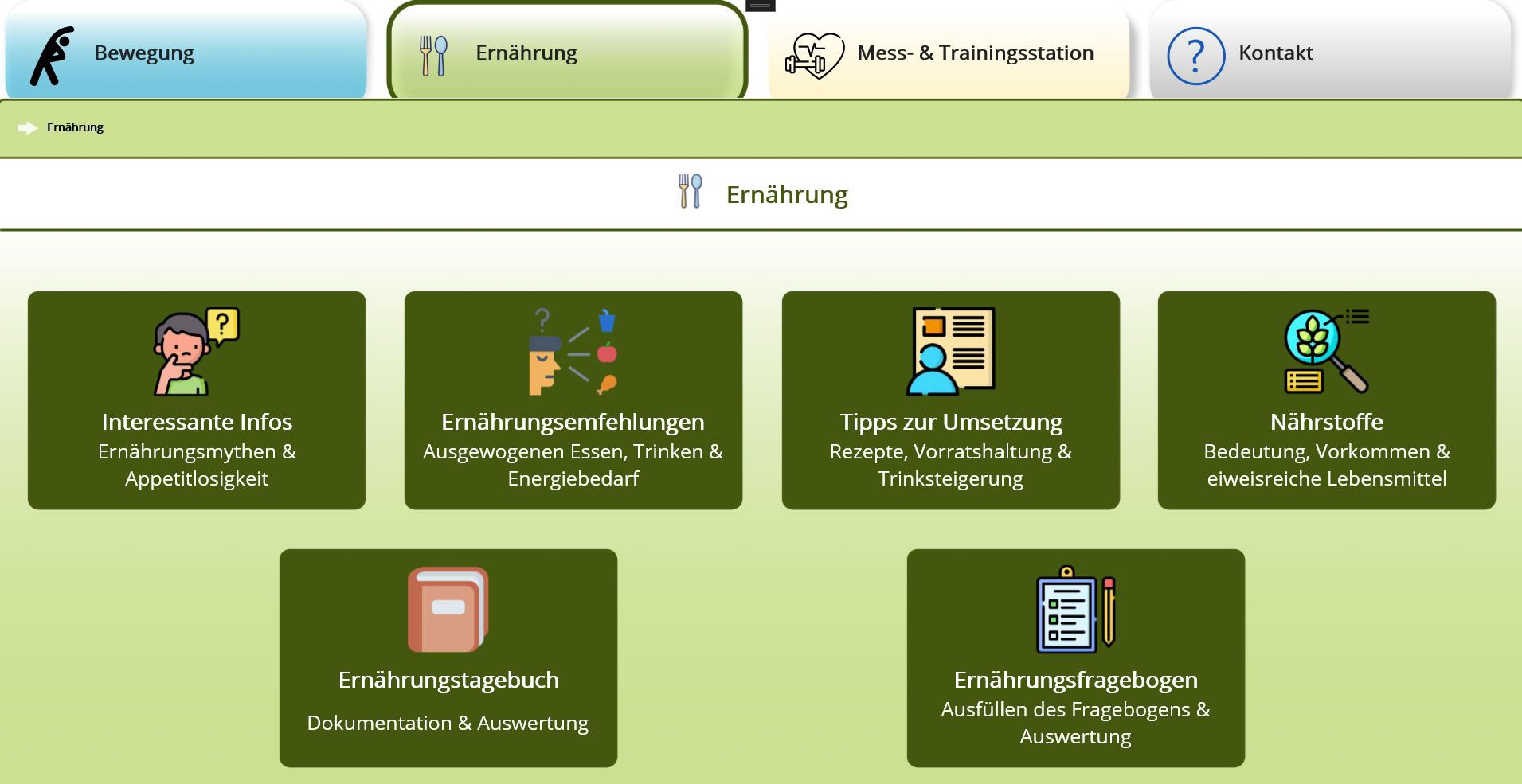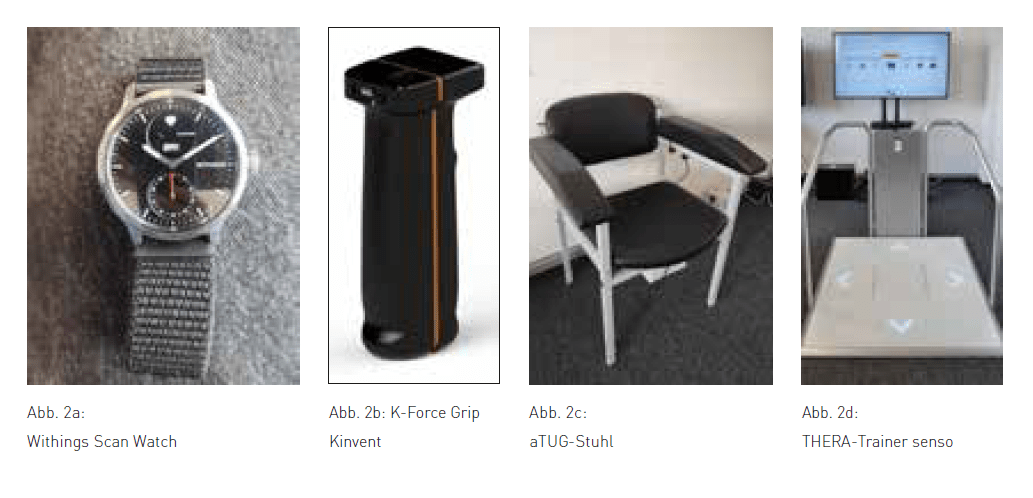
THERAPY-Magazin
Development of a technical assistance system to improve nutrition and mobility in old age
Discover how a smart assistance system combining an app and sensor-based training improves nutrition and mobility in seniors. Results from focus groups and pilot studies.

Redaktion
THERAPY Magazin
Older adults often experience deficiencies in nutrition and physical activity, two key factors that are essential for maintaining health. Technical assistance systems that enable individuals to independently conduct health measurements and training to monitor/improve health could preserve autonomy and reduce adverse health outcomes (Zager Kocjan et al. 2023).
In the AS-Tra project (assistance system for the sustainable improvement of the nutritional and mobility status of older people taking into account the transtheoretical model of behaviour change), we are developing and evaluating an innovative technical assistance system aimed at improving the nutrition and mobility of older adults aged 70 and older. In order to achieve a high level of usability and to align the station with the needs of the target group, older adults are involved in the development in the form of focus group discussions and iterative user studies.
The two main components of the assistance system are a tablet-based app and a measuring and training station. The underlying concept is for the app to be used independently by older adults in their everyday lives. The measuring and training station enables independent training and assessments of physical functioning, and provides user feedback. Carrying out nutrition and exercise tests can contribute to the early detection of possible risks and deficits. The information obtained in the measuring and training station is transferred directly to the app, allowing the results to be displayed and used for features such as reminder functions.
The two main components of the assistance system are a tablet-based app and a measuring and training station. The underlying concept is for the app to be used independently by older adults in their everyday lives. The measuring and training station enables independent training and assessments of physical functioning, and provides user feedback. Carrying out nutrition and exercise tests can contribute to the early detection of possible risks and deficits. The information obtained in the measuring and training station is transferred directly to the app, allowing the results to be displayed and used for features such as reminder functions.
Tablet-based app
The app interface offers four different areas: Mobility, nutrition, measuring and training station, and contact. In the areas of mobility and nutrition, informative elements such as texts, videos and quizzes are integrated, e.g. on exercise recommendations, specific nutrients or nutrition myths. There are also interactive elements, such as the exercise and food diary, in which the users can directly document their exercises and what they have eaten during the day.
Fig. 1a shows the mobility page and Fig. 1b the nutrition page, with the sub-topics presented in colour-coded tiles with corresponding symbols. Navigation cues for the four different areas of the app are displayed at the top of each screen.
The app interface offers four different areas: Mobility, nutrition, measuring and training station, and contact. In the areas of mobility and nutrition, informative elements such as texts, videos and quizzes are integrated, e.g. on exercise recommendations, specific nutrients or nutrition myths. There are also interactive elements, such as the exercise and food diary, in which the users can directly document their exercises and what they have eaten during the day.
Fig. 1a shows the mobility page and Fig. 1b the nutrition page, with the sub-topics presented in colour-coded tiles with corresponding symbols. Navigation cues for the four different areas of the app are displayed at the top of each screen.

Fig. 1a: App screen on mobility with the corresponding sub-topics

Fig. 1b: App screen on nutrition with the corresponding sub-topics
Measuring and training station
The measurement and training section of the app integrates various devices that are used in the station. These include a heart rate monitor, a hand strength measuring device, an automated Timed Up & Go test and an interactive training device for testing and training cognitive-motor skills – the Senso. The app runs on a stationary computer and is operated via a 55-inch touchscreen. Users are guided through the tests and training sessions by means of integrated explanations and explanatory videos. The results achieved can be viewed at the end of these tests.
The Withings Scan Watch (Withings, model HWA09, Fig. 2a) is used for heart rate measurement. Hand force is measured with the K-Force Grip Kinvent (SAS Kinvent Biomechanique, KFORCE Grip) (Fig. 2b). This device connects to the computer via Bluetooth and measures hand strength in kilograms when the user presses it, as though making a fist. This test is helpful in drawing conclusions about general muscle status and is considered a predictor of functional deterioration.
The third measurement is the automated Timed Up & Go test (aTUG), which is used to determine walking speed, among other things (Fudickar et al. 2020; Fudickar et al. 2022, Fig. 2c). With four force sensors and an infrared light barrier, the aTUG chair automatically recognises whether a person is sitting on it with their back leaning against the backrest. The test starts with an acoustic signal. The test subject stands up, walks three metres straight ahead, turns behind a marker, returns to the chair and sits down again. The crossing of the marker, as well as the action of sitting down again, are detected using light barriers, and the walking speed is calculated (Hellmers et al. 2018). The results of this test can be used to draw conclusions about general mobility and the risk of falling (Podsiadlo and Richardson 1991).
The measurement and training section of the app integrates various devices that are used in the station. These include a heart rate monitor, a hand strength measuring device, an automated Timed Up & Go test and an interactive training device for testing and training cognitive-motor skills – the Senso. The app runs on a stationary computer and is operated via a 55-inch touchscreen. Users are guided through the tests and training sessions by means of integrated explanations and explanatory videos. The results achieved can be viewed at the end of these tests.
The Withings Scan Watch (Withings, model HWA09, Fig. 2a) is used for heart rate measurement. Hand force is measured with the K-Force Grip Kinvent (SAS Kinvent Biomechanique, KFORCE Grip) (Fig. 2b). This device connects to the computer via Bluetooth and measures hand strength in kilograms when the user presses it, as though making a fist. This test is helpful in drawing conclusions about general muscle status and is considered a predictor of functional deterioration.
The third measurement is the automated Timed Up & Go test (aTUG), which is used to determine walking speed, among other things (Fudickar et al. 2020; Fudickar et al. 2022, Fig. 2c). With four force sensors and an infrared light barrier, the aTUG chair automatically recognises whether a person is sitting on it with their back leaning against the backrest. The test starts with an acoustic signal. The test subject stands up, walks three metres straight ahead, turns behind a marker, returns to the chair and sits down again. The crossing of the marker, as well as the action of sitting down again, are detected using light barriers, and the walking speed is calculated (Hellmers et al. 2018). The results of this test can be used to draw conclusions about general mobility and the risk of falling (Podsiadlo and Richardson 1991).
The Senso (THERA-Trainer) is used as the training device (Fig. 2d). This device has five force plates, which are used to operate it. On the Senso, users can select different exergames to train cognitive-motor skills such as reaction speed, balance and coordination. The movements can be recorded via the force plates. For people with balance problems, for example, there is the option of holding on to the metal bars.
The results of the measurements and training sessions are displayed graphically and in text form in the app. If people use the station regularly over a certain period of time, they can easily track their progress and are incentivised to improve.
The results of the measurements and training sessions are displayed graphically and in text form in the app. If people use the station regularly over a certain period of time, they can easily track their progress and are incentivised to improve.

Results of initial studies
Five focus groups, comprising a total of n = 21 older adults and an average age of 78.5 years, were used to identify the basic willingness and interest in the independent use of technical-digital systems to record and improve nutrition and mobility. The focus group participants were shown various training devices (exercise stairs, Posturomed, Senso, recumbent bicycle, digital exercise instructions and feedback) by means of pictures and videos.
Five focus groups, comprising a total of n = 21 older adults and an average age of 78.5 years, were used to identify the basic willingness and interest in the independent use of technical-digital systems to record and improve nutrition and mobility. The focus group participants were shown various training devices (exercise stairs, Posturomed, Senso, recumbent bicycle, digital exercise instructions and feedback) by means of pictures and videos.
Owing to its ludic and motivating character, along with the ability to adjust the intensity, the THERA-Trainer senso was favoured by the users as a training device.
In addition, the first two iterative study cycles have already been carried out, in which the usability of the developed prototypes was tested across an entire station, including the app.
The next round of iterative testing deals with the scenario of independent use without testers in the same room. Instructions are provided through the playback of voice recordings, and the performance of each test is monitored and evaluated using camera footage and eye-tracking data. A pilot study will then be carried out to test the independent application in long-term use. The assistance system is used independently by the participants over a period of three weeks and its implementation in everyday life and feasibility are tested, taking into account the phases of the transtheoretical model for behavioural change (TTM) (Lippke and Renneberg 2006).
Finally, a two-arm randomised controlled study with a control and an intervention group will be conducted to assess the long-term effects on nutritional and mobility status.
The next round of iterative testing deals with the scenario of independent use without testers in the same room. Instructions are provided through the playback of voice recordings, and the performance of each test is monitored and evaluated using camera footage and eye-tracking data. A pilot study will then be carried out to test the independent application in long-term use. The assistance system is used independently by the participants over a period of three weeks and its implementation in everyday life and feasibility are tested, taking into account the phases of the transtheoretical model for behavioural change (TTM) (Lippke and Renneberg 2006).
Finally, a two-arm randomised controlled study with a control and an intervention group will be conducted to assess the long-term effects on nutritional and mobility status.
Fachkreise
Science
senso
THERAPY 2024-I
THERAPY Magazine
Wohnen im Alter & Langzeitpflege

Redaktion
THERAPY Magazin
References:
- Diekmann, Rebecca; Wojzischke, Julia (2018): The role of nutrition in geriatric rehabilitation. In: Current Opinion in Clinical Nutrition & Metabolic Care 21 (1), S. 14–18. Fudickar, Sebastian; Kiselev, Jörn; Frenken, Thomas; Wegel, Sandra; Dimitrowska, Slavica; Steinhagen-Thiessen, Elisabeth; Hein, Andreas (2020): Validation of the ambient TUG chair with light barriers and force sensors in a clinical trial. In: Assistive Technology 32 (1), S. 1–8. Fudickar, Sebastian; Pauls, Alexander; Lau, Sandra; Hellmers, Sandra; Gebel, Konstantin; Diekmann, Rebecca et al. (2022): Measurement system for unsupervised standardized assessments of timed up and go test and 5 times chair rise test in community settings—a usability study. In: Sensors 22 (3), S. 731. Happe, Lisa; Sgraja, Marie; Hein, Andreas; Diekmann, Rebecca (2022): Iterative development and applicability of a tablet-based e-coach for older adults in rehabilitation units to improve nutrition and physical activity: usability study. In: JMIR Human Factors 9 (1), e31823. Hellmers, Sandra; Izadpanah, Babak; Dasenbrock, Lena; Diekmann, Rebecca; Bauer, Jürgen M.; Hein, Andreas; Fudickar, Sebastian (2018): Towards an automated unsupervised mobility assessment for older people based on inertial TUG measurements. In: Sensors 18 (10), S. 3310. Lippke, Sonia; Renneberg, Babette (2006): Theorien und modelle des gesundheitsverhaltens. In: Gesundheitspsychologie, S. 35–60. Podsiadlo, Diane; Richardson, Sandra (1991): The timed “Up & Go”: a test of basic functional mobility for frail elderly persons. In: Journal of the American geriatrics Society 39 (2), S. 142–148. Zager Kocjan, Gaja; Špes, Tanja; Svetina, Matija; Plohl, Nejc; Smrke, Urška; Mlakar, Izidor; Musil, Bojan (2023): Assistive digital technology to promote quality of life and independent living for older adults through improved self-regulation: a scoping review. In: Behaviour & Information Technology 42 (16), S. 2832–2851.
Related contents
Find related exciting contents in our media library.
This is not what you are searching for? Knowledge
Meet our specialists.
Are you interested in our solutions? Schedule a meeting with a Consultant to talk through your strategy and understand how TEHRA-Trainer can help you to advance rehabilitation.
You need to load content from reCAPTCHA to submit the form. Please note that doing so will share data with third-party providers.
More InformationYou are currently viewing a placeholder content from Turnstile. To access the actual content, click the button below. Please note that doing so will share data with third-party providers.
More Information